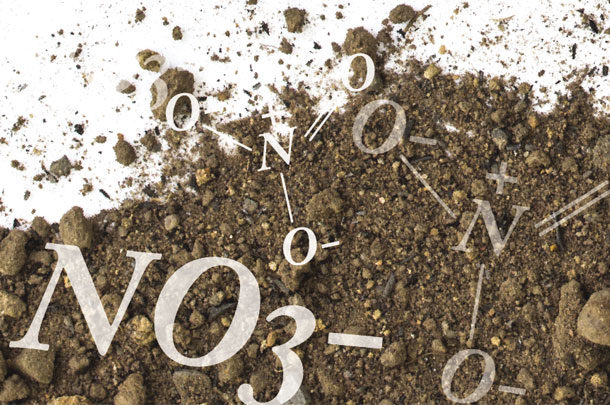Carbon, hydrogen, oxygen and nitrogen – known colloquially as CHON – are the four elements that form the building blocks of all life. Without CHON, fundamental elements such as water, protein and even DNA simply would not exist.
In other words, these are important elements. Just like anything important, more must always be better, right? The obvious answer is no, more is not always better. The power is in the balance. Too much of anything can tip the scales from good to bad in a quick minute. For example, we need oxygen in the form of O2 in order to survive. If one more atom of oxygen comes to that party, O2 becomes O3, also known as ozone, and becomes a hazard.
Our desire to harness nature makes CHON of unique interest in agriculture. Though each element carries equal importance, nitrogen is the only one of these ingredients that we actively manage. Unless, that is, you’ve recently begun applying oxygen to your crop. In that case, we need to have a talk. Holding true to the adage that more of a good thing is not always a good thing, managing nitrogen in forage production requires a year-round strategy that must have a component outside of the growing season. Because of nitrogen’s role in CHON, it’s an active player in nature and can change forms readily. The nitrate, or NO3, form is of particular interest in managing forage crops because it can have serious implications on animal health down the road.
Too much of a good thing
All crops contain nitrate, but when in excess, a problem can occur. When forages high in nitrate are fed to ruminants, rumen activity can break down the nitrates into ammonia, which can be further converted by bacteria into microbial protein. In this process, nitrate loses an oxygen and becomes nitrite, NO2. This byproduct of the conversion is the real cause of “nitrate poisoning.” Once nitrite enters the bloodstream, it changes the oxygen-carrying mechanism, limiting the oxygen supply to body tissues. Nitrates can also cause dilation of blood vessels, further complicating oxygen transport.
When elevated levels of nitrates are fed, one or several of the following symptoms may be observed in livestock: slobbering, drooling, rapid or difficult breathing, poor appetite, abortions, lower production or growth, muscle tremors, diarrhea, frequent urination, dark-colored blood and death.
Effective management of nitrate levels in forages starts with an understanding of nitrate’s role within the plant. Being a living thing, all plants rely on CHON for their existence. What makes nitrogen different is that it’s taken into the plant primarily through the root system, making soil and soil/water interactions a primary focus of management practices. Being that nitrate is readily water-soluble, it is the form of nitrogen that’s most preferred by plants, and its abundance and availability in the soil is driven by several factors.
Forming a plan
Fall and winter nitrate management requires a plan, and in many forage operations, nitrogen management is manure management. Many growers and producers have a nutrient management plan (NMP) that guides manure applications, but if such a plan doesn’t exist on your operation, the winter season is a great time to begin the process.
Following an NMP is only the first step, though. Manure application equipment must also be properly calibrated in order to know how much manure is being applied. Weather is another important factor to consider. Just because an NMP is in place does not mean the weather will concur. If adverse weather requires manure overapplications, fields should be monitored through soil tests for excess nitrate. Overapplication of commercial nitrogen fertilizer should always be avoided, if possible.
Winter and spring can add to nitrogen management complications. If manure was applied in fall, a preplant nitrate test (PPNT) can be performed the following spring to evaluate how much nitrogen is still available to the coming crop. During the growing season, side dressing is a great way to tailor nitrogen applications to each field. A pre-sidedress nitrate test (PSNT) can be performed to determine how much nitrogen is needed to close the gap between previous applications and crop demand.
A final factor in decreasing nitrates in harvested forage is minimizing stress during the growing season. This can include many factors like keeping fertility and pH at adequate levels, but also means keeping insect and disease pressure to a minimum.
Reducing nitrates in harvest
Once nitrate is taken up in the plant, it is converted to amino acids and proteins through photosynthesis. Sunlight, therefore, is also a driving factor in harvested material nitrate levels. When nitrates are a concern, harvest on bright, sunny days and avoid harvesting during long-term cloudy stretches. This will give the crop every opportunity to convert those nitrates.
The shade the canopy creates for the lower part of the plant also slows the conversion of nitrate in lower portions of the plant. Raising the cutter bar when harvesting can help to keep high-nitrate stems out of harvested material and should be another tactic considered when nitrate levels are of concern.
More importantly, do not harvest three to five days after a drought-breaking rain. The crop may take up excess nitrogen but then does not have ample time to utilize, convert or dissipate that nitrate. Frost also can “trap” nitrates in the plant – thus, immediate harvest should be avoided. If a crop is suspected to be high in nitrates, consider ensiling the forage, as the ensiling process will decrease the nitrate level by 40% to 60%.
If grazing the crop, avoid putting animals to pasture in a field where conditions may increase the possibility of higher nitrate levels. This, again, would be three to five days after a drought-breaking rain, or immediately after a frost. If that timing cannot be avoided, try not to turn them out when they are hungry; offer a safe feed first so they do not overconsume the high-nitrate forage.
Nitrate consumption
The most valuable tool in the animal nutritionist’s toolbox is the forage test. It’s important to have suspected forage tested prior to feeding. Nitrate levels should be considered based on the total diet, not just one ingredient. Water is often overlooked in the diet. Sometimes, water sources can contribute a significant amount of nitrate to the diet and should be considered, especially when troubleshooting.
Typically, a nitrate value of less than 3,000 parts per million (ppm) is considered safe for tested feeds. 3,000 to 6,000 ppm of nitrate would be of concern (especially for pregnant or young animals), and caution should be taken. Feeds higher in nitrate should be diluted with low-nitrate feeds. Feeds harboring between 6,000 and 9,000 ppm of nitrate should be limited to less than half of the total dry matter of the diet, and even then, animals may show signs and symptoms. Feeds containing 9,000 ppm of nitrate should not be fed.
There is a lot to consider when overseeing animal health and nutrition, but nitrates should be one of the priorities. Nitrate management can seem complicated and daunting, but with a whole-farm, year-round approach of routine testing and manure management, nitrate concentration control will surely follow. Eventually, these guides become inherent in the operation, and CHON can become an ally.













